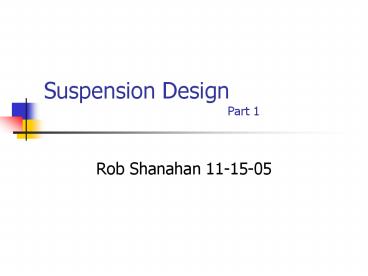Suspension Design Part 1 - PowerPoint PPT Presentation
1 / 26
Title:
Suspension Design Part 1
Description:
Toe In / Out. 4. Ride Height, Bump ... cars often use front toe-out, & rear toe-in. 8. Common Suspension Designs ... Caused when toe changes as suspension ... – PowerPoint PPT presentation
Number of Views:444
Avg rating:3.0/5.0
Title: Suspension Design Part 1
1
Suspension Design Part 1
- Rob Shanahan 11-15-05
2
Introduction
- What is an Automotive Suspension?
- An Automotive Suspension is the system of parts
that give a vehicle the ability to maneuver. - It is a 3 Dimensional Four Bar Linkage
- What does a suspension do?
- The job of a car suspension is to maximize the
friction between the tires and the road surface,
to provide steering stability with good handling
HowStuffWorks.com
3
Basic Suspension Terminology
- Ride Height
- Bump / Droop
- Camber
- Caster
- Toe In / Out
4
Ride Height, Bump Droop
- Ride Height
- The neutral / middle position of the Suspension
- Bump
- When the wheel moves upwards
- Droop
- When the wheel moves downwards
5
Camber
- Tires generate more cornering force with a small
amount of negative camber - Camber changes as suspension moves up (bump) and
down (droop)
6
Caster
- Shopping cart action
- Causes self-centering action in the steering
- More caster results in more camber as front
wheels are turned
7
Toe-in or Toe-out
- Toe-in results is inherently stable
- Toe-out is inherently unstable
- Race cars often use front toe-out, rear toe-in
8
Common Suspension Designs
- Beam Axle
- Swing Axle
- De Dion
- Double Wishbone /
- Unequal Length A-arm
9
Beam Axle
- Around since horse and chariot days
- Always keeps wheels parallel
- Often used in rear
- Rarely used in front
- OK on smooth tracks
10
Swing Axle
- Often used on VW based off road cars
- Simple and rugged
- Camber curve too steep
- Only adjustment you can make is ride height
11
De Dion
- Essentially a beam axle with the diff now sprung
weight - Keeps wheels parallel
- Relatively light weight
- Better on smooth tracks
12
Double Wishbone
- Lightest weight
- Lowest unsprung mass
- Greatest adjustability
13
Basic Vehicle Dynamics Part 2
- What is Vehicle Dynamics?
- The understanding and study of how a vehicle and
its components move and react
14
Yaw, Pitch, and Roll
- Same terminology as aircraft
- X is the longitudinal axis
- Yawing refers to normal change of direction
- Pitching is dive or squat
15
Understeer
- Front end of the car washes out or doesnt
turn in - NASCAR boys call it push or tight
- Safe, because lifting off throttle reduces it
- Most road cars have a ton of it
16
Oversteer
- Rear end of car slides out
- NASCAR boys call it loose
- Excessive application of power can cause
oversteer - Throttle induced oversteer is never the fast way
around a corner
17
Weight Transfer
- Occurs anything the vehicle accelerates or
decelerates - Cornering force Fc will cause weight to transfer
from the inside to outside tires - Braking and accelerating forces cause a similar
front and rear weight transfer
18
Roll Center
- A geometric construct
- Represents the instantaneous point about which
the sprung mass will rotate due to cornering
forces - Roll center moves as suspension travels
- Goal of any suspension designer is to minimize
Roll Center Migration
19
Roll Couple
- Distance from roll center to CG is key
- Low roll center results in more roll for a given
lateral acceleration - Most designs use a low roll center to reduce
jacking forces
20
Anti-dive
- Purely geometric method to reduce pitch movement
- Reduces suspension compliance over bumps
- No longer in favor with formula car and sports
racers - Might work well for Baja
21
Bump Steer
- Caused when toe changes as suspension moves up
and down - Causes car to react unexpectedly over bumps and
in roll - Sometimes used intentionally, but be careful
22
Tire Slip Angle
- Angle between the centerline of the wheel and the
actual path - Tires generate highest cornering forces at a
certain slip angle
23
Slip Angle vs. Grip
- Grip is highest a set angle, then falls off as
the slip angle increases - Sharper peak will give a less predictable
breakaway - Radial tires typically have a steeper slope than
bias ply
24
Friction Circle
- Plots the theoretical limits of adhesion in 2
axes - Great tool for analyzing driver to driver
variation - G-analyst is a cheap tool for this
25
Friction Circle, cont.
- Illustrates the trade off between cornering and
braking/accelerating - The driver that follows the path closest to the
outside of the circle wins
26
Car Balance
- A well balanced car will exhibit both understeer
and oversteer at different points on the course
and at corner entry and exit - A good driver can change his technique to change
the basic oversteer/understeer balance































